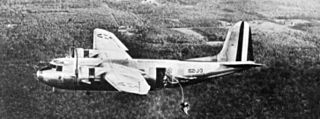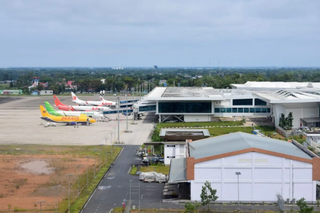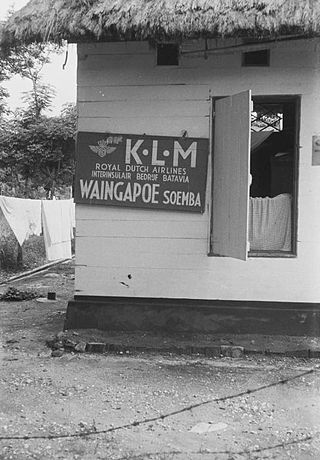
KLM Royal Dutch Airlines, or simply KLM, is the flag carrier of the Netherlands. KLM is headquartered in Amstelveen, with its hub at nearby Amsterdam Airport Schiphol. It is a subsidiary of the Air France-KLM group and a member of the SkyTeam airline alliance. Founded in 1919, KLM is the oldest operating airline in the world, and has 35,488 employees with a fleet of 110 aircraft as of 2021. KLM operates scheduled passenger and cargo services to 145 destinations.

The Douglas DC-5 was a 16-to-22-seat, twin-engine propeller aircraft intended for shorter routes than the Douglas DC-3 or Douglas DC-4. By the time it entered commercial service in 1940, many airlines were canceling orders for aircraft. Consequently, only five civilian DC-5s were built. With the Douglas Aircraft Company already converting to World War II military production, the DC-5 was soon overtaken by world events, although a limited number of military variants were produced.

Soewondo Air Force Base is currently a military airbase in Medan, North Sumatra, Indonesia. Before 2013, this airport served commercial flights, and was known as Polonia International Airport which was the principal airport serving Medan, about 2 km from the downtown; it used to serve flights to several Indonesian and Malaysian cities, along with a flight to Singapore and Thailand. Previous international flights had been opened to Hong Kong, Taipei, Amsterdam, Phuket, Chennai, Johor Bahru, Malacca and Ipoh.
PT Merpati Nusantara Airlines, operating as Merpati Nusantara Airlines, was an airline in Indonesia based in Central Jakarta, Jakarta. It operated scheduled domestic services to more than 25 destinations in Indonesia, as well as scheduled international services to East Timor and Malaysia. The word merpati is Indonesian for "dove", and Nusantara is a Javanese word found in the Pararaton meaning "the outer islands", referring to the Indonesian archipelago. The airline was based at Soekarno-Hatta International Airport, Jakarta. It also maintained both a maintenance and simulator facility at Juanda International Airport, Surabaya. The Merpati Training Centre at Surabaya housed Fokker F-27, AVIC MA60 and CN-235 full motion simulators.

PT Indonesia AirAsia, operating as Indonesia AirAsia, is an Indonesian low-cost airline based in Tangerang, Banten. It operates scheduled domestic and international services and is an Indonesian associate carrier of the Malaysian AirAsia. Its main base is Soekarno–Hatta International Airport in Jakarta. Indonesia AirAsia is listed in category 1 by the Indonesian Civil Aviation Authority for airline safety quality.
Sempati Air was an airline based in Indonesia. Partially owned by friends and family of President Suharto of Indonesia, the airline ceased operations due to bankruptcy after its owner Suharto's May 1998 presidential resignation. Its IATA code has since been reassigned to SpiceJet.

Jenderal Ahmad Yani Airport is an airport serving the city of Semarang, in Central Java, Indonesia. The airport is named in honor of Ahmad Yani (1922–1965), who is a National Hero of Indonesia. As of 2018, it was one of the fastest-growing airports in the world by growth percentage. The airport is operated by PT Angkasa Pura I, a state enterprise of the Indonesian Ministry of Transportation that manages airports in the eastern part of the country.

Syamsudin Noor Airport is an airport serving Banjarmasin in South Kalimantan, Indonesia. It is located in the district of Landasan Ulin, 5 km (3.1 mi) west of Banjarbaru, the capital of South Kalimantan, and about 25 km (16 mi) southeast from the centre of the city of Banjarmasin, the largest city of South Kalimantan. The airport served more than 5.3 million passengers in 2017.

Kemayoran Airport, also known in its old spelling as Kemajoran, was the principal airport in Jakarta, Indonesia from 1940 until 1985. Kemayoran was built during Dutch East Indies administration by the Department of Transport, Public Works and Irrigation in 1934 on the land that was formerly swamps, rice fields, and residential areas.

The Fokker F.XII was a three-engined high-winged monoplane airliner produced in the 1930s by the Dutch aircraft manufacturer Fokker. Two aircraft were built under license by Danish Orlogsværftet. The first was powered by 347 kW (465 hp) Bristol Jupiter VI radial engines and the second, an improved model, the F.XIIM, was about 20 km/h (12 mph) faster than the Dutch-built F.XIIs.

The Fokker F.XVIII was an airliner produced in the Netherlands in the early 1930s, essentially a scaled-up version of the Fokker F.XII intended for long-distance flights. Like its predecessor, it was a conventional high-wing cantilever monoplane with fixed tailwheel undercarriage. Its cabin could seat 12 passengers, or four-to-six on seats convertible to sleeping berths. Only five were built, all for KLM, and registered as PH-AIO, 'AIP, 'AIQ, 'AIR and 'AIS, all of which were named after birds. Used by KLM on its Amsterdam-Batavia route, the F.XVIII became celebrated in the Netherlands due to two especially noteworthy flights. In December 1933, one aircraft was used to make a special Christmas mail flight to Batavia, completing the round trip in a flight time of 73 hours 34 minutes. The following Christmas, another F.XVIII made a similar flight to Curaçao in 55 hours 58 minutes after having been specially re-engined for the journey.

The Directorate General of Civil Aviation is a Directorate General under the control of the Ministry of Transportation of the Republic of Indonesia, which oversees the administration of civil aviation throughout the nation. The office of the Directorate General of Civil Aviation oversees all government regulations pertaining to civil aviation and the Aviation Act. Its headquarters is in Jakarta.

The colonial architecture of Indonesia refers to the buildings that were created across Indonesia during the Dutch colonial period, during that time, this region was known as the Dutch East Indies. These types of colonial era structures are more prevalent in Java and Sumatra, as those islands were considered more economically significant during the Dutch imperial period. As a result of this, there is a large number of well preserved colonial era buildings that are still densely concentrated within Indonesian cities in Java and Sumatra to this day.

Freemasonry was introduced by the Dutch to what is today Indonesia during the VOC era in the 18th century, and spread throughout the Dutch East Indies during a wave of westernisation in the 19th century. Freemasons originally only included Europeans and Indo-Europeans, but later also indigenous people with a Western education.

Koninklijke Luchtvaart Maatschappij Interinsulair Bedrijf Batavia was an airline based in the Dutch East Indies and the predecessor to Garuda Indonesia.
Pacific Royale Airways was an Indonesian commercial airline which received its government flight license in November 2011. It received a formal Air Operator's Certificate (AOC) in May 2012, and made its first flight on June 11, 2012. On 6 September 2012, the airline ceased operations on a temporary basis, before having its license revoked on 19 November 2012.

Aviation in Indonesia serves as a critical means of connecting the thousands of islands throughout the archipelago. Indonesia is the largest archipelagic country in the world, extending 5,120 kilometres (3,181 mi) from east to west and 1,760 kilometres (1,094 mi) from north to south, comprising 13,466 islands, with 922 of those permanently inhabited. With an estimated population of over 255 million people — making it the world's fourth-most-populous country — and also due to the growth of the middle-class, the boom of low-cost carriers in the recent decade, and overall economic growth, many domestic travellers shifted from land and sea transport to faster and more comfortable air travel. Indonesia is widely regarded as an emerging market for air travel in the region. Between 2009 and 2014, the number of Indonesian air passengers increased from 27,421,235 to 94,504,086, an increase of over threefold.

















